
Are you offended by this poster?
Is any word particularly offensive to you?
Would it make any difference if the word wasn’t intended to offend?
Should words like that, even if not meant to be offensive, be tolerated in public space?
I’ve been thinking about these questions all week after a couple of odd Twitter conversations about this poster and others in the same series.

They have been appearing across the city recently advertising a book, a work of fiction, called People Like This. The novel is set in Leeds. The writer, Steven George, claims that some of his posters have been damaged and defaced, and Leeds City Council have been less than helpful when it comes to replacing them.
Here’s the screenshots of the gist of the discussion.
@philkirby street signs have received an email from Leeds City council. No more posters with the word ‘immigrant’ allowed up. All replaced
— steven george (@stevengeorgePLT) June 23, 2015
Afternoon @LeedsCC_Help don’t suppose you know anything about these signs? They are ads for a book set in Leeds. pic.twitter.com/jLlGFQIcGd
— Phil Kirby (@philkirby) June 23, 2015
@philkirby It may not be the intention but as currently worded some of the posters may cause offence so have been removed. Others can stay.
— Leeds Council Help (@LeedsCC_Help) June 23, 2015
As you can see Leeds Council Help admit there was no intent to offend. But “as currently worded” the posters “may cause offense so have been removed.” The author tells me an email from Leeds City Council states that “no more posters with the word immigrant are allowed up.” Reassuringly, Leeds Council Help Tweets that “others can stay.”
Steven George wrote a book set in Leeds. He put some posters up around Leeds advertising his book.
He didn’t get a grant for writing a novel. He paid for the posters himself.
I’d say that’s civic enterprise.
That’s something the council supports, isn’t it?
Apparently not, “as currently worded.”
The claim is that the words on the posters are ambivalent and may cause some (unspecified) people to take (non-specific) offence, though nobody has actually made a complaint as far as I can tell (Leeds Council Help didn’t respond to my question so I may be wrong about that.) The writer is being reprimanded for ambiguous syntax. For constructing a phrase that could be construed in more than one way. And for using a word that could be misinterpreted.
Not for being actually offensive in any way.
In a thoughtful, democratic, tolerant city anyone who complained of feeling offended by “wording” that isn’t actually offensive would be quietly taken aside and patiently educated about art and irony and verbal playfulness. The wording concerned, blame immigrants for your failings, and if you can’t blame immigrants, who can you blame? is actually what we’d call up North, a bit of a piss take. The wording does not discriminate against immigrants. The wording mocks those who would use immigration to score mean, nasty, intolerant political points. If you can’t see this wording as the irony it evidently is then that is a problem for you. But don’t blame a writer for doing his job, making language fun.
When did it become the council’s job to pre-emptively take offence so we don’t have to. That is beyond patronising.
The wording that caused the problem was on a poster placed in Hyde Park.
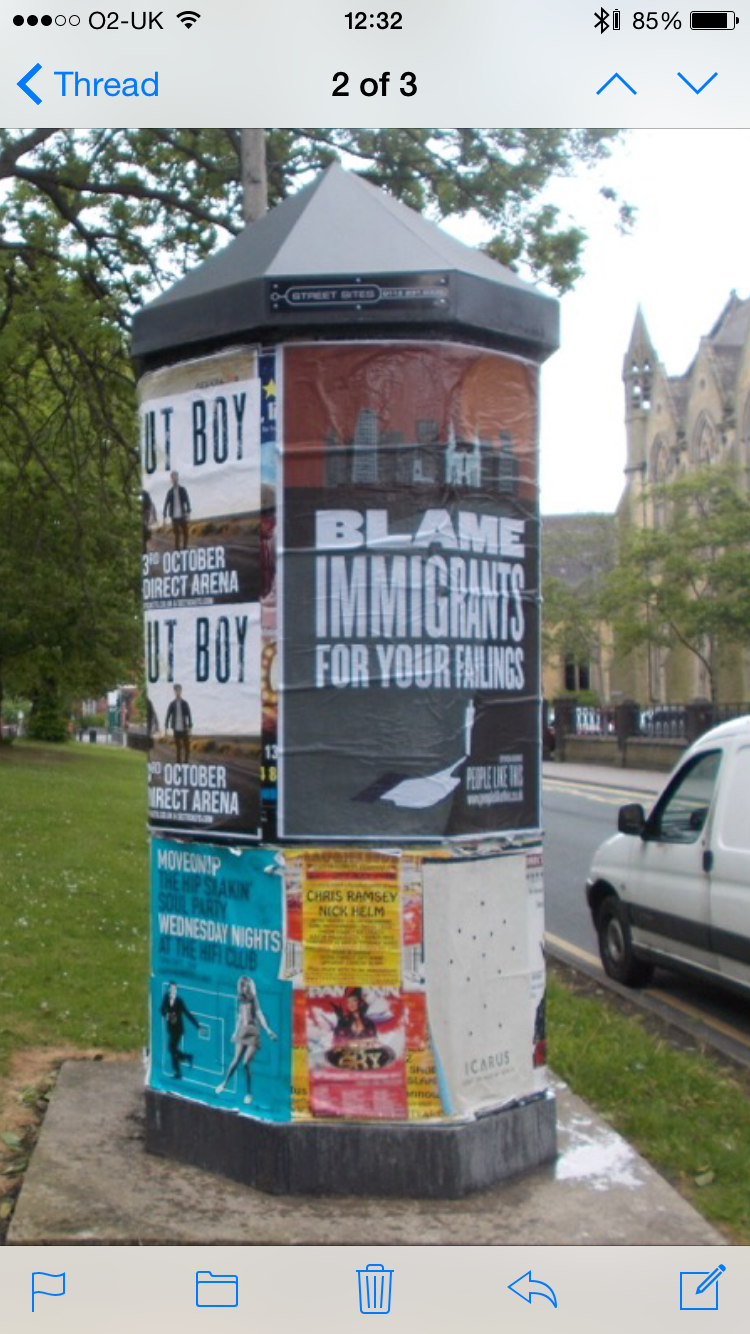
If the mere mention of the word “immigrant” in the academic quarter is enough to wind up the Mary Whitehouse brigade and set them off then what hope is there for us in Armley and Beeston and Harehills and Gipton?
Surely any Leeds undergrad could see the wink in the eye in the wording? Should be perceptive enough to see that these posters weren’t produced by the nasty party? The visual grammar of the British right wing tends to a bombastic literalism and stark, simplistic imagery. Anyone who read the design of these posters as offensive needs a remedial class in visual literacy, surely?
Or am I wrong?
Here’s a few more posters. I like them.
But then, I’m not easily offended.
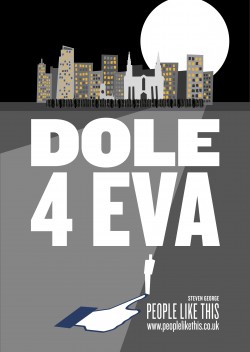
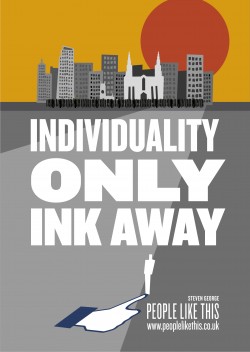
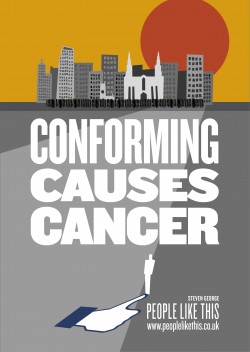
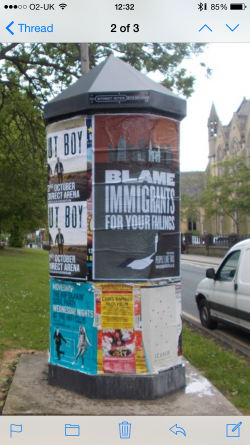
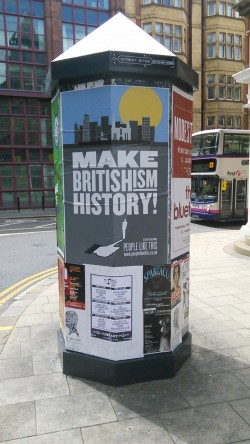
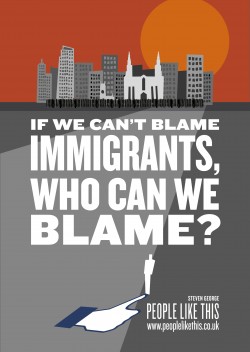
I think it’s odd that you characterise the viewer as a “Leeds undergraduate” and talk about “offence”. Shouldn’t the question be whether these posters make people who are immigrants, who may or may not also be Leeds undergraduates, feel unsafe and unwelcome? And if someone is here in Leeds as, say, a refugee, and they see a poster that says “blame immigrants” and don’t realise that it’s a witty hipster advertisement but think it’s coming from the same place as the right-wing tabloids, or a sneer from someone who hears their accent, or the hostile authorities who have grudgingly let them out of Yarls Wood, or some racist graffiti, and feels attacked and unsafe, is that something to casually discount because the artist’s freedom takes precedence?
I don’t know if the answer is automatically yes or no to that last question, but I think it’s a harder one to answer than the question of whether some “Leeds undergraduate” feels “offended”. These posters are obviously designed to mimic right-wing, anti-immigrant rhetoric, with a cheesy “haha not really gotcha” for those who look closely. It’s one thing to claim the artist’s purpose is more important than someone’s “offence”. Is it more important for you than making someone feel unsafe? Is it clever and witty and enterprising to make someone who has left their home country because of a war or political persecution feel that Leeds is a hostile place?
The reference to the “Leeds undergrad” was made in the specific context of the sentence about the defaced poster in Hyde Park, next to the university campus.
The posters are not designed to mimic anything. As I made explicit several times in this very short piece, the posters were advertising a novel. A work of fiction. Words that someone made up. In a novel if everyone said only nice, inoffensive, politically sanitized words to each other it probably would be so boring it wouldn’t be worth reading (I say “probably” as I’ve never had the experience of reading any such novel. I wouldn’t know what it would be like.)
Again, my point was that the posters were not actually offensive. If the council want to spend valuable time and resources removing “wording” I’d prefer they removed the really and truly offensive stuff that’s scrawled all over the place and maybe left the “witty hipster” stuff alone. There’s plenty right-wing, racist, anti-immigrant graffiti to keep them occupied without worrying themselves about the productions of a lone local novelist. That would make the city a more welcoming place, actually.
I’ve only managed to speak to a handful of immigrants so far about the posters. Their general reaction was to shrug, and laugh; “got many worse problems than a poster.” One interesting reaction was to say that back home nobody would dare put up anything that could be interpreted as being slightly at odds with the ruling orthodoxy. That’s what they were trying to get away from.
I’d like to welcome people to an adult, thoughtful, and yes, clever and witty and enterprising city, one open to different ways of talking about things, one where it’s ok to experiment and play. I think that’s what immigrants to our city deserve.
Good piece Phil. I’m surprised the ‘immigrants’ poster lasted as long as it did. It certainly wouldn’t have got past the dungareed dictators at the university.
I actually don’t mind so much that some twerp takes offence at a poster and does a bit of damage. I object that the council take pre-emptive offence and censors “wording” in order to protect our delicate sensitivities. And will not be honest and open about it.
As for the people who think it’s about making others feel safe and welcome… hmm, removing arty posters advertising a novel about immigration is certainly an easier option than tackling the real problems in the city.
Whoa – what’s this all about then?
Potentially LCC can take one of three views on matters of “free speech” in the visual environment.
(1) Laissez-faire – meaning basically anything goes. This seems to be broadly Phil’s position although he does seem to think that it OK for them to clean up some graffiti which he or right thinking people like him judge to be “racist”.
(2) They can act on complaints – if someone complains they have been offended by something in the visual environment even if they were mistaken (according to some other criteria such as the author’s intention) then LCC can think itself justified in acting to remove the offence.
(3) They can proactively remove anything they think themselves could cause offence believing themselves to be acting in some sort of protective capacity for the public good. Phil seems happy that they can do this in some circumstances but not others defined perhaps in terms of “artistic merit” or wit?
For what it is worth I’m not too fussed either way by these posters except to back up any “immigrant” who did complain.
Personally I’m more concerned with the much wider field in which LCC involves itself with “managing” the visual environment of the city of which posters and graffiti is only a small part.
Similar “conversations” are possible around architecture, urban design, conservation and public art and against which the actions or inactions of LCC can be judged.
So – although there is a highly restrictive planning system in the city nonetheless critics have argued that the architecture of the Leeds Renaissance was effectively “laissez –faire” and as result we got Bridgewater Place and the city centre eastern “gateway”. Laissez-faire for developers is what happens but just don’t think of building a small extension or putting decking in your garden.
With public art the council seems basically fairly easy going as much of it is paid for by other people anyway except where there are complaints e.g. around the colour of the crossed gates in Crossgates. Really imaginative was that one. Only with the Brick man fiasco did LCC protect its citizens from such an abhorrent visual intrusion.
Conservation policy generally seems to hold to the hidden code that Victorian or before is intrinsically good: anything post WW2 inherently bad. In this instance protecting the city’s memory of its glorious industrial and imperial past from the days when these excesses were being were to some extent being addressed.
But mostly though the various branches of the civic visual police argue these issues in private through various vacuous design guides, “neighbourhood design statements”, action plans and policy documents meaning that we can never know what we didn’t see.
Suitably
Sour
As always John I mostly agree with you – though I think you went off on a bendy rail after your first 3 points…
Just to make things clear, I’d say my position was more libertarian than laissez faire. So, not “everything goes” but everything is allowed unless there’s clear evidence of actual harm (or “fighting speech”, words calling for actual harm, which does complicate things, I agree.) Offending words do no harm. The wording on the posters was deliberately ambivalent, as befits an advert for a book. No harm was done, intended, or called for. Offence, if any were taken – and there’s no evidence any was – would be out of all proportion to the provocation. I didn’t see why the council saw fit to remove any poster. But as I said, if the posters were damaged by a passing offence-taker, that’s just bad luck. Don’t put posters up in a big city and expect everyone to appreciate them.
Your other point about “right thinking people like me” acting as judge of what counts as racist and arbiter of the public’s aesthetic well-being, is just a jibe isn’t it? I’d support the council removing any graffiti/poster/artwork that called for actual harm. I tweeted a few examples that appeared recently less than 30 yards from my front door, opposite a Junior school (Death to Islam! being an example…they get nastier.) I don’t object to things like this because they lack wit or aesthetic merit (which they don’t) or owing to them not satisfying my superior ethical-political standard (I don’t really own one), but simply because they actively call for attacking certain sections of the community. I’d be happy if the council put resources into removing that sort of thing and would be willing to argue the case if you think I’m being overly censorious. But the only criteria I think is relevant is harm, not offence, and my judgement may not be correct in all cases – same with the council – which is why we need democratic debate not high-handed diktats.
I was confused by your comment that you didn’t find anything wrong with the posters but “would back up any “immigrant” who did complain.” Back up how? To do what? And would any of your conversation be about what the posters were for? Would that be relevant?
The rest of your comment I heartily endorse. We’d probably argue about the brick man though (think you were showing your own high-minded aesthetic there, John! Made me laugh, and it is worth saying.)
According to the council’s own policy, a designated member of its staff can order advertising contractors to remove a poster when it’s on council land and after a complaint that that council bod judges to be justified.
It all seems a bit arbitrary: what this one council bloke says goes (in terms of what constitutes public offence), the person who made the posters doesn’t seem to have a right to challenge the decision, and no record of the decision is made public (at least it hasn’t yet in this case).
If it’s not on council land it looks like it has bugger all to do with the council, as the complainant has to go through the Advertising Standards Authority.
I does seem a bit high handed. And not much help to the guy who bought and paid for the posters. There doesn’t seem to be any way he can challenge the decision. The council don’t even need to respond… I thought those days were over?
No problem here Phil – I mostly agree with you and your post has cleared up some of the inconsistencies that I felt were in your original post.
I totally agree that pre-emptive censorship as you describe is a major threat to notions of free speech – which is what you were basically saying. If the council’s “policy” is as arbitrary, un-transparent and unaccountable as the Citizen says if merely confirms ones worst fears.
You have clarified what grounds you would exclude words from public display. Although whenever this occurred you might have to defend this against those who would take and absolutist position on free speech even to the extent of challenging the law. So of course “right thinking was a jibe – just to get you come clean.
You are not completely out of the woods though because you raise the issue of what you would consider an appropriate complaint over which action could be taken and those which in your view are not – in this case you seem as if you would not accept any complaint as justifiable as the intention of the posters was clear (it was an ad), the words used were not offensive, and any complaint would be out of proportion to the scale of “provocation”. Fair enough if this is your view.
My position is different in the sense that I find the word “immigrant” to be tainted now by its over use by the far right and others – so if I had this cultural background I might take offence. Should the issue have come to light in any other way than this forum e.g. some minor campaign and this had come to Sour’s notice he might have expressed his view in any available medium, got on to his political contacts, turned up at demo or whatever. In my case I would judge this complaint to be valid.
On this Brick Man just be clear I was parodying the arguments of our Civic Leaders of the time – who by their ignorance, complacency and conservatism denied Leeds citizens their of “Angel of the North”. I think the model has now gone from the Art Gallery (possibly another act of political censorship)- apologies if I’m being high minded here.
I’m glad you enjoy humour – incidentally where are Greenland and Grumpius hiding – they deserve another roasting
Bye for now
Sour